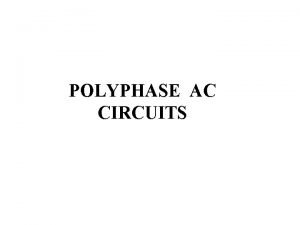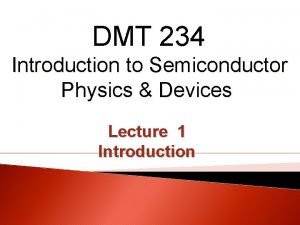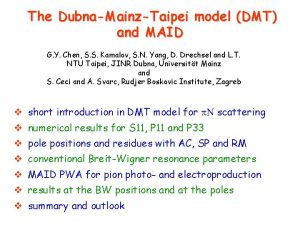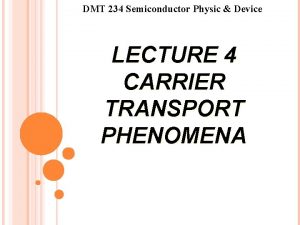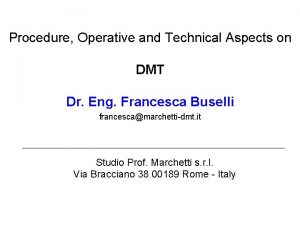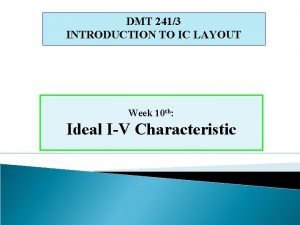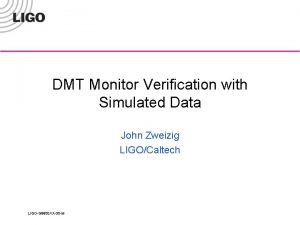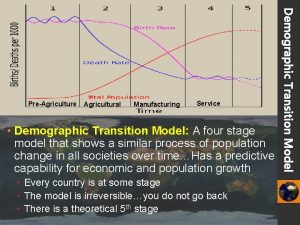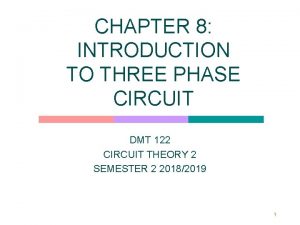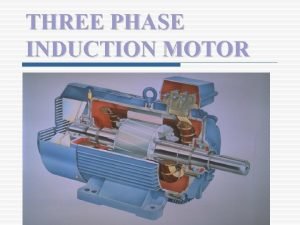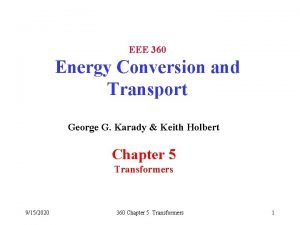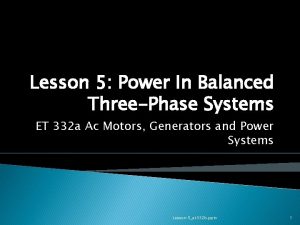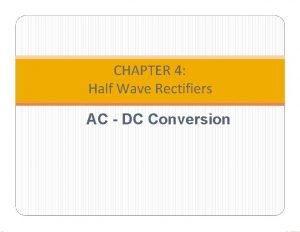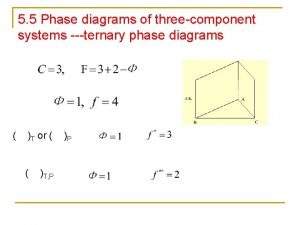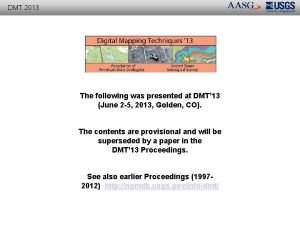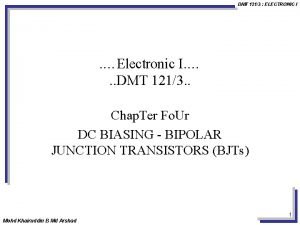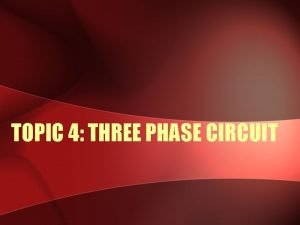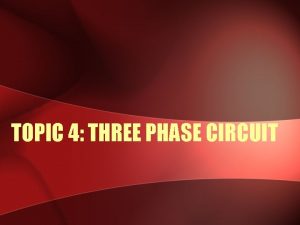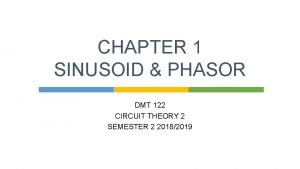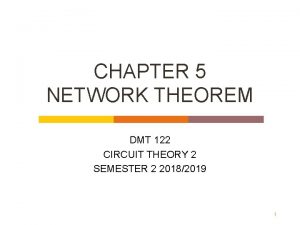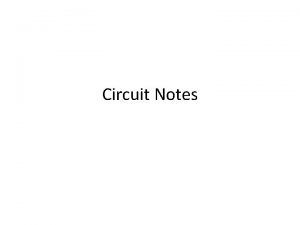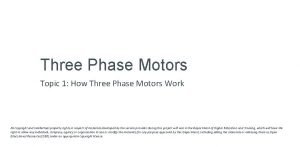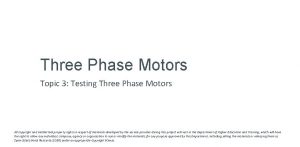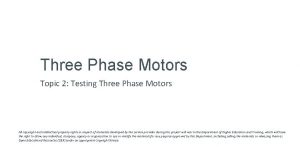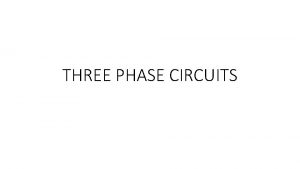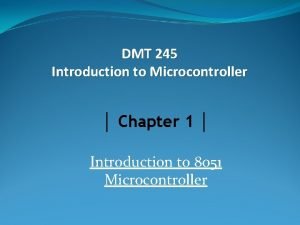CHAPTER 8 INTRODUCTION TO THREE PHASE CIRCUIT DMT




































- Slides: 36

CHAPTER 8: INTRODUCTION TO THREE PHASE CIRCUIT DMT 122 CIRCUIT THEORY 2 SEMESTER 2 2018/2019 1

SINGLE PHASE SYSTEM Two wire type Three wire type 2

SINGLE PHASE SYSTEM § A generator connected through a pair of wire to a load – Single Phase Two Wire. § Vp is the magnitude of the source voltage, and is the phase. § Use at normal household 3

2 -PHASE SYSTEM § A generator consists of two coils placed perpendicular to each other § The voltage generated by one lags the other by 90. 4

3 -PHASE SYSTEM § A generator consists of three coils placed 120 apart. § Consist of 3 sources § The voltage generated are equal in magnitude but, out of phase by 120. 5

IMPORTANCE OF 3 - PHASE SYSTEM § All electric power is generated and distributed in three phase. § Uniform power transmission (instantaneous power is constant) and less vibration of three phase machines. § Three phase system is more economical than the single phase. 6

BALANCED 3 -PHASE VOLTAGES § Produced with a 3 -phase ac generator. § Generator consist of rotating magnet (rotor) & stationary winding (stator) § 3 separate windings (coils) with terminal a-a’, b-b’ and cc’ placed 120° apart around the stator § When rotor rotates, magnetic field induced a voltage with same magnitude but of phase 120°. Balanced 3 -phase voltages : equal in magnitude & out of phase by 120° 7

BALANCED 3 VOLTAGES § Balanced three phase voltages: § same magnitude (VM ) § 120 phase shift +ve sequence -ve sequence 8

BALANCED 3 CURRENTS § Balanced three phase currents: § same magnitude (IM ) § 120 phase shift 9

POSITIVE PHASE SEQUENCE § POSITIVE SEQUENCE (abc)10

NEGATIVE PHASE SEQUENCE § NEGATIVE SEQUENCE (acb) 11

DETERMINE THE SEQUENCE USING PHASOR DIAGRAM 12

EXAMPLE 1 § EXAMPLE 2 13

3 -PHASE QUANTITIES QUANTITY SYMBOL Phase current I Phase voltage V Line current IL Line voltage VL 14

PHASE VOLTAGES and PHASE CURRENTS § Phase voltage (V ) : measured between the neutral and any line voltage. § Phase current (I ) : the current in each phase of the source or load. 15

PROPERTIES OF PHASE VOLTAGE § 16

PROPERTIES OF PHASE CURRENT § All phase currents have the same magnitude, § Out of phase with each other by 120 17

LINE VOLTAGES and LINE CURRENTS § Line voltage (VL) : measured between any two of the three lines. § Line current (IL) : the current in each line of the source or load. 18

PROPERTIES OF LINE VOLTAGE § 19

PROPERTIES OF LINE CURRENT § All line currents have the same magnitude, § Out of phase with each other by 120 20

BALANCED VOLTAGE AND LOAD § Balanced Phase Voltage: All phase voltages are equal in magnitude and are out of phase with each other by 120. § Balanced Load: The phase impedances magnitude and in phase. are equal in 21

SOURCE-LOAD CONNECTION SOURCE LOAD Wye (Y) Delta (∆) CONNECTION 22

SOURCE LOAD Delta (∆) Wye (Y) CONNECTION 23

BALANCED Y-Y CONNECTION § 24

BALANCED Y-Y CONNECTION § Total impedance per phase, ZY 25

BALANCED Y-Y CONNECTION § 26

BALANCED Y-Y CONNECTION § 27

BALANCED Y-Y CONNECTION § 28

EXAMPLE 3 § Calculate : (assume negative sequence) i. The line voltages ii. The line currents 29

EXAMPLE 4 Calculate : (assume positive sequence) i. The line voltages ii. The line currents 30

BALANCED ∆ - ∆ CONNECTION § 31

BALANCED ∆ - ∆ CONNECTION § 32

BALANCED ∆ - ∆ CONNECTION § 33

BALANCED ∆ - ∆ CONNECTION § 34

EXAMPLE 5 A balanced delta connected load having an impedance 20 -j 15 is connected to a delta connected, positive sequence generator having Vab = 330 0 V. Calculate : i. the phase currents ii. the line currents. 35

EXAMPLE 6 § 36
 Polyphase ac
Polyphase ac Introduction to semiconductor physics
Introduction to semiconductor physics Dmt 234
Dmt 234 Dmt 234
Dmt 234 Dmt
Dmt Physic
Physic The pythagorean theorem
The pythagorean theorem Dmt
Dmt Dmt fabrication
Dmt fabrication Layout dmt
Layout dmt Dmt monitor
Dmt monitor Population decline
Population decline A balanced delta connected load having an impedance 20-j15
A balanced delta connected load having an impedance 20-j15 Motor equivalent circuit
Motor equivalent circuit Normal phase vs reverse phase chromatography
Normal phase vs reverse phase chromatography M tswett pronunciation
M tswett pronunciation Mobile phase and stationary phase
Mobile phase and stationary phase Mobile phase vs stationary phase
Mobile phase vs stationary phase Normal phase vs reverse phase chromatography
Normal phase vs reverse phase chromatography Line current and phase current
Line current and phase current Hplc detector types
Hplc detector types In a ∆-connected source feeding a y-connected load
In a ∆-connected source feeding a y-connected load Broad phase vs narrow phase
Broad phase vs narrow phase 3 phase short circuit
3 phase short circuit Series vs parallel
Series vs parallel Types of circuit
Types of circuit Circuit construction kit
Circuit construction kit Capacitor series parallel
Capacitor series parallel What is a incomplete circuit
What is a incomplete circuit Short circuit example
Short circuit example Series and parallel circuits similarities
Series and parallel circuits similarities Pulmonary circuit and systemic circuit
Pulmonary circuit and systemic circuit Series parallel circuit current
Series parallel circuit current Three phase model of operant conditioning
Three phase model of operant conditioning Power formula three phase
Power formula three phase Single phase uncontrolled half wave rectifier
Single phase uncontrolled half wave rectifier Three component system phase diagram
Three component system phase diagram
